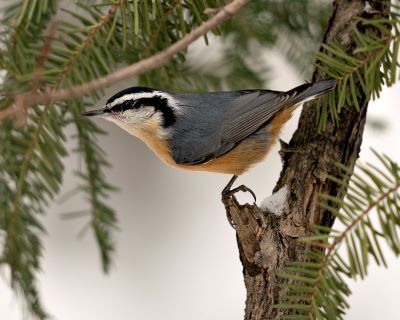
Good Natured: Tis' the Season for Nature's Gifts
Ah, Christmas. The actual day might have passed, but the nostalgic spirit of the season lingers on…
I remember the excitement of going to bed Christmas Eve, knowing that Santa would soon be by with all the rooty toot toots and rummy tum tums us kids could handle. I also recall the joy of racing downstairs in the dim pre-dawn light and discovering packages of all shapes and sizes nestled beneath the boughs of a regal pine, spruce or fir.
What I didn't know then, yet am keenly aware of now, is that every day can be Christmas when you're a naturalist.
Although pine, spruce and fir trees aren't native to Kane County, they nonetheless are present in abundance. Folks plant them for their ever-greenness; their dark, year-round foliage and mostly triangular shapes make them ideal accent trees across our generally deciduous landscape. Those same green leaves (and yes, they really are leaves, even though we tend to call them needles) also make for great windbreaks, which is why you'll often see these trees planted in rows along country lanes, farmhouses and crop fields.
Where you find windbreaks, you'll also find wildlife. And that's where the Christmas part comes in. Just like the brightly decorated trees found indoors this time of year, the evergreens we have outdoors yield treasures of all types too.
An exploration of the limbs of various conifers often yields some insight into who called the tree home during the breeding season. Thanks to the shelter these branches provide, I've found nests from all sorts of species, including cardinals, blue jays and robins; even the rickety assemblages mourning doves build last into the winter months when protected by evergreen boughs.
Then we have the gift of the live birds themselves. Conifer needles catch snowflakes that then build up and provide tree-mendous protection from wind and additional precipitation. When the snow starts to fly, many birds that live here year-round, as well as some here only in the winter, flock to pines, firs and spruce.
For instance, these trees are a favorite of red-breasted nuthatches. Although a few stay in our area year round, now is the time of year to look for them in greater numbers as more head this way for the winter months.
In comparison to its cousin the locally common white-breasted nuthatch, the red-breasted nuthatch, or RBNU for short, is smaller, with a black stripe through the eyes and a breast of rusty orange.
The birds also can be identified by their behavior. Like other members of the Sittadae, or nuthatch family, red-breasted nuthatches move downward, and head first, as they forage on trees and at feeding stations. They also can be spotted using their exquisite, tweezer-like bills to pluck seeds from conifer cones.
While you're looking, be sure to be listening too. The call of the red-breasted nuthatch is a sort of a nasally “yank" sound, often likened to the toot of a little tin horn.
Another great place to look for conifer-y gifts is below the tree, among the fallen needles. Like presents arrayed on a tree skirt, small nature trinkets abound: chewed nutshells left by squirrels and mice (bigger teethmarks = squirrels, smaller teethmarks = mice and voles); bird droppings (with a little practice you can learn to identify who “went" there; mourning doves, for example, create small mounds of coiled waste that look like miniature servings of soft-serve ice cream); and the treasure that trumps them all, owl pellets.
Wrapped up in tightly bound packages of fur, bits and pieces of bone, teeth, claws and sometimes feathers, pellets are owls' gifts to nature lovers. Big pellets—the size of two thumbs stacked on top of each other—are the work of great horned owls, Bubo virginianus, our region's biggest owls; little pellets, about the size of your pinky toe, emerge from the much smaller screech owl, Megascops asio.
Keeping in mind that lots of birds besides owls (like hawks and crows) seek shelter in evergreens and also produce pellets, the game of identify-the-pellet can take on a secret-Santa like quality. And since birds produce pellets frequently, you can find them under trees during every month of the year.
New Year's Day is just around the corner, and soon the holiday season will be just a faint blur in our rearview mirror. But thanks to evergreens and their resident critters, every day can be Christmas…when you're a naturalist.
Pam Otto is the outreach ambassador for the St. Charles Park District. She can be reached at potto@stcparks.org.

